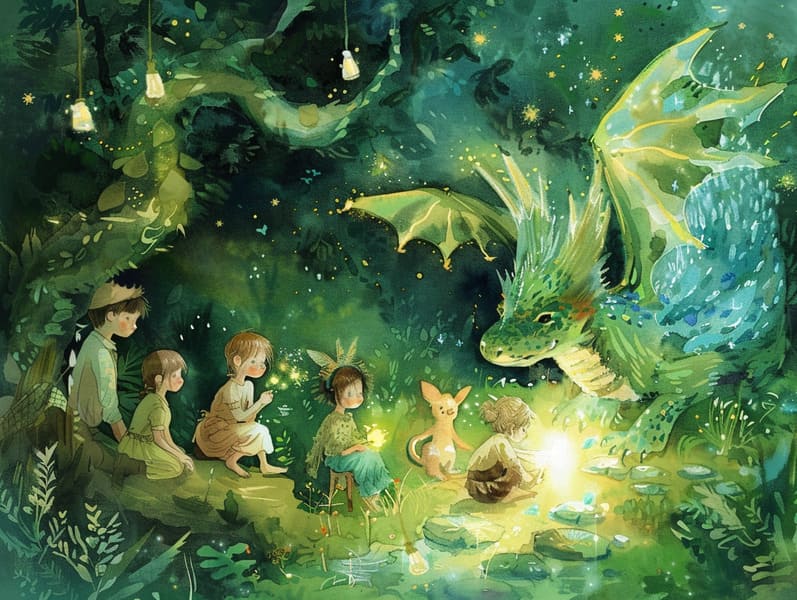Delving into the Background of Traditional Fairy Tales and the Perpetual Enchantment.
Delving into the Background of Traditional Fairy Tales and the Perpetual Enchantment.
Blog Article

Classic fairy tales have old origins. These narratives have been transmitted from one generation to the next well before they were ever published. They originated from a variety of traditions, including Indigenous traditions. They were initially narrated among adults, often carrying themes and messages concerning the societal norms and beliefs of the time.
The renowned Brothers Grimm, Jacob and Wilhelm Grimm, were among the first to compile and release many of these beloved tales. Their compilation, "Grimm's Folk Tales," included narratives like "The Little Glass Slipper," "Little Brother and Little Sister," and "Snow-White and Rose-Red," which have since become cornerstones in the world of classic fairy tales. Similarly, Andersen's charming tales, such as "The Little Mermaid," and "The Little Duckling," have stolen hearts worldwide, securing their place in the pantheon of famous fairy tales.
Despite their ancient origins, fairy tales remain as applicable as ever, especially as kids' bedtime tales. These whimsical stories are now available in various formats, including gorgeously illustrated books, enchanting animations, and free fairy tales online.
Their unwavering allure can be traced to several captivating elements:
Moral Lessons: Classic fairy tales often offer important moral lessons. Narratives like "The Tale of the Boy Who Cried Wolf" teach the virtue of truth, while "The Tortoise and the Hare" demonstrate the merits of resolve and unpretentiousness. These stories offer young readers clear distinctions between virtue and vice, guiding their moral compass in a subtle yet meaningful way.
Warmth and Understanding: Ancient fairy tales frequently illustrate individuals facing trials and tribulations, encouraging young listeners to feel with their struggles and root for their triumphs. For instance, "The Story of Beauty and the Beast" points out the merit of looking past the exterior to perceive the inner spirit of a being, encouraging understanding and comprehension.
Cultural Recognition: Many timeless fairy tales are interwoven with the cultural contexts from which they arose. Immersing in these fairy tales can provide fascinating glimpses into different customs, encouraging a sense of global appreciation and discernment.
Creativity and Imagination: The extraordinary elements in ancient fairy tales—wizardry and magic—invigorate children’s fantasy worlds. These tales lead readers to magical realms, invigorating fantastical thinking and a sense of mystery that endures a lifetime.
Old fairy tales are not only fascinating but also enlightening. They act as charming tools in developing various brain and heart skills in young ones. When timeless fairy tales are narrated, they develop language proficiency by offering new language and detailed sentence structures. This practice also improves auditory perception and focus, as kids keep up with the story, ready to see what happens next.
Furthermore, discussing the themes and characters of fairy tales can sharpen thought processes and logical thinking. Young ones are educated to identify patterns, expect results, and catch on to cause and effect. These analyses also facilitate young readers speak out their thoughts and feelings, contributing to their emotional intelligence.
In today’s online age, the presence of online storybooks has made these narratives more accessible than ever. Websites and digital apps extend ample collections of ancient fairy tales that can be accessed or listened via anytime, anywhere. Fairy tales voiced are particularly common, presenting an fascinating method for the young to relish these mesmerizing stories. Voice books and spoken videos transport characters and settings to life, often enhanced by entrancing soundtracks and songs that improve the story adventure.
The unfading fascination of timeless fairy tales lies in their ability to alter to modern times while maintaining their key morals. Contemporary revisions of these tales often include more diverse figures and modern settings, making them familiar to today’s audience. However, the basic principles of spirit, humanity, and impartiality remain unchanged, continuing to move young readers of all ages.
Traditional fairy tales also offer a sense of protection and recognition. They put out a structured narrative with a definite beginning, middle, and end, often closing with the conclusion of conflicts and the triumph of morality over immorality. This consistency can be solacing for children, bringing a sense of security in an unstable world.
Ancient fairy tales continue to captivate and coach new generations, maintaining their delight and applicability in modern society. As kids' bedtime tales, they provide a perfect blend of charm and understanding, fostering moral values, empathy, and creativity. The abundance of digital storybooks and the prevalence of fairy tales spoken certify that these ancient stories remain attainable to this site new generations.
By safeguarding and releasing these tales, we continue to glorify the rich tapestry of lore and cultural heritage. Whether you are delving into a vividly illustrated book, experiencing a online library, or listening on an read-aloud book, the fascination of traditional fairy tales is always within reach. These tales convey of the eternal ability of narratives and its ability to link us across time and space.
No matter if you are discovering a beautifully illustrated book, discovering a internet library, or listening on an voice book, the majesty of children's fairy tales is always within reach.
These tales point out of the enduring effect of narratives and its ability to link us across time and space, casting a charm that charms and informs alike.